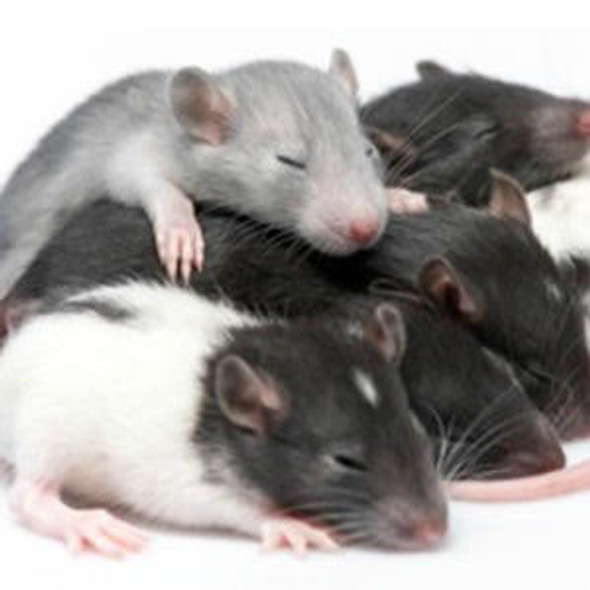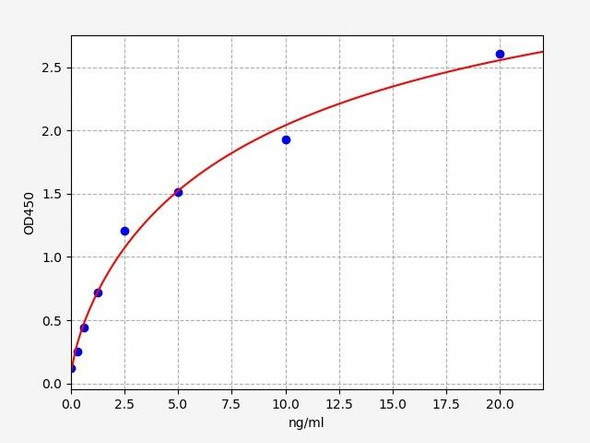Rat Cyclin D1 ELISA Kit
- SKU:
- RTFI00212
- Product Type:
- ELISA Kit
- Size:
- 96 Assays
- Uniprot:
- P39948
- Sensitivity:
- 0.094ng/ml
- Range:
- 0.156-10ng/ml
- ELISA Type:
- Sandwich ELISA, Double Antibody
- Synonyms:
- Ccnd1, BCL-1, PRAD1 oncogene, B-cell lymphoma 1 protein, BCL-1 oncogene, BCL1, PRAD1, Cyclin-D1, Cyl-1, cyclin D1, G1, S-specific cyclin D1, G1, S-specific cyclin-D1, PRAD1B-cell CLL, lymphoma 1
- Reactivity:
- Rat
Description
| Product Name: | Rat Ccnd1 (G1/S-specific cyclin-D1) ELISA Kit |
| Product Code: | RTFI00212 |
| Size: | 96 Assays |
| Target: | Rat Ccnd1 |
| Alias: | Ccnd1, BCL-1, PRAD1 oncogene, B-cell lymphoma 1 protein, BCL-1 oncogene, BCL1, PRAD1, Cyclin-D1, Cyl-1, cyclin D1, G1, S-specific cyclin D1, G1, S-specific cyclin-D1, PRAD1B-cell CLL, lymphoma 1 |
| Reactivity: | Rat |
| Detection Method: | Sandwich ELISA, Double Antibody |
| Sensitivity: | 0.094ng/ml |
| Range: | 0.156-10ng/ml |
| Storage: | 4°C for 6 months |
| Note: | For Research Use Only |
| Recovery: | Matrices listed below were spiked with certain level of Rat Ccnd1 and the recovery rates were calculated by comparing the measured value to the expected amount of Rat Ccnd1 in samples. | ||||||||||||||||
| |||||||||||||||||
| Linearity: | The linearity of the kit was assayed by testing samples spiked with appropriate concentration of Rat Ccnd1 and their serial dilutions. The results were demonstrated by the percentage of calculated concentration to the expected. | ||||||||||||||||
| |||||||||||||||||
| Intra-Assay: | CV <8% | ||||||||||||||||
| Inter-Assay: | CV <10% |
| Uniprot: | P39948 |
| UniProt Protein Function: | CCND1: a member of the highly conserved cyclin family, whose members are characterized by a dramatic periodicity in protein abundance through the cell cycle. Cyclins function as regulators of CDK kinases. Forms a complex with and functions as a regulatory subunit of CDK4 or CDK6, whose activity is required for cell cycle G1/S transition. This protein has been shown to interact with tumor suppressor protein Rb and the expression of this gene is regulated positively by Rb. |
| UniProt Protein Details: | Protein type:Oncoprotein; Activator; Cell cycle regulation; Nuclear receptor co-regulator Cellular Component: nucleoplasm; tight junction; transcriptional repressor complex; membrane; cytoplasm; cyclin-dependent protein kinase holoenzyme complex; intracellular; nucleus Molecular Function:enzyme binding; histone deacetylase binding; protein complex binding; kinase activity; cyclin-dependent protein kinase regulator activity; transcription corepressor activity; transcription factor binding; protein kinase binding; protein kinase activity Biological Process: G1 DNA damage checkpoint; lactation; fat cell differentiation; re-entry into mitotic cell cycle; negative regulation of Wnt receptor signaling pathway; positive regulation of cyclin-dependent protein kinase activity; regulation of cell cycle; response to glucocorticoid stimulus; positive regulation of mammary gland epithelial cell proliferation; negative regulation of epithelial cell differentiation; Wnt receptor signaling pathway through beta-catenin; negative regulation of transcription from RNA polymerase II promoter; response to organic cyclic substance; protein amino acid phosphorylation; response to estradiol stimulus; response to organic substance; response to magnesium ion; response to vitamin E; Leydig cell differentiation; positive regulation of cell proliferation; response to iron ion; response to corticosterone stimulus; response to X-ray; response to drug; organ regeneration; Wnt receptor signaling pathway; transcription, DNA-dependent; unfolded protein response; mammary gland epithelial cell proliferation; liver development; response to organic nitrogen; response to ethanol; cell division; response to steroid hormone stimulus; response to estrogen stimulus; positive regulation of protein amino acid phosphorylation; response to calcium ion; regulation of protein kinase activity; response to DNA damage stimulus; G1/S transition of mitotic cell cycle |
| NCBI Summary: | regulatory subunit of CDK4 or CDK6; involved in regulation of the G1/S transition of the cell cycle [RGD, Feb 2006] |
| UniProt Code: | P39948 |
| NCBI GenInfo Identifier: | 148356229 |
| NCBI Gene ID: | 58919 |
| NCBI Accession: | NP_741989.3 |
| UniProt Related Accession: | P39948 |
| Molecular Weight: | Predicted Molecular Mass: 34.7kDaAccurate Molecular Mass: 34kDa as determined by SDS-PAGE reducing conditions. |
| NCBI Full Name: | G1/S-specific cyclin-D1 |
| NCBI Synonym Full Names: | cyclin D1 |
| NCBI Official Symbol: | Ccnd1 |
| NCBI Protein Information: | G1/S-specific cyclin-D1 |
| UniProt Protein Name: | G1/S-specific cyclin-D1 |
| Protein Family: | G1/S-specific cyclin |
| UniProt Gene Name: | Ccnd1 |
| UniProt Entry Name: | CCND1_RAT |
| Step | Procedure |
| 1. | Set standard, test sample and control (zero) wells on the pre-coated plate respectively, and then, record their positions. It is recommended to measure each standard and sample in duplicate. Wash plate 2 times before adding standard, sample and control (zero) wells! |
| 2. | Aliquot 0.1ml standard solutions into the standard wells. |
| 3. | Add 0.1 ml of Sample / Standard dilution buffer into the control (zero) well. |
| 4. | Add 0.1 ml of properly diluted sample ( Human serum, plasma, tissue homogenates and other biological fluids.) into test sample wells. |
| 5. | Seal the plate with a cover and incubate at 37°C for 90 min. |
| 6. | Remove the cover and discard the plate content, clap the plate on the absorbent filter papers or other absorbent material. Do NOT let the wells completely dry at any time. Wash plate X2. |
| 7. | Add 0.1 ml of Biotin- detection antibody working solution into the above wells (standard, test sample & zero wells). Add the solution at the bottom of each well without touching the side wall. |
| 8. | Seal the plate with a cover and incubate at 37°C for 60 min. |
| 9. | Remove the cover, and wash plate 3 times with Wash buffer. Let wash buffer rest in wells for 1 min between each wash. |
| 10. | Add 0.1 ml of SABC working solution into each well, cover the plate and incubate at 37°C for 30 min. |
| 11. | Remove the cover and wash plate 5 times with Wash buffer, and each time let the wash buffer stay in the wells for 1-2 min. |
| 12. | Add 90 µL of TMB substrate into each well, cover the plate and incubate at 37°C in dark within 10-20 min. (Note: This incubation time is for reference use only, the optimal time should be determined by end user.) And the shades of blue can be seen in the first 3-4 wells (with most concentrated standard solutions), the other wells show no obvious color. |
| 13. | Add 50 µL of Stop solution into each well and mix thoroughly. The color changes into yellow immediately. |
| 14. | Read the O.D. absorbance at 450 nm in a microplate reader immediately after adding the stop solution. |
When carrying out an ELISA assay it is important to prepare your samples in order to achieve the best possible results. Below we have a list of procedures for the preparation of samples for different sample types.
| Sample Type | Protocol |
| Serum: | If using serum separator tubes, allow samples to clot for 30 minutes at room temperature. Centrifuge for 10 minutes at 1,000x g. Collect the serum fraction and assay promptly or aliquot and store the samples at -80°C. Avoid multiple freeze-thaw cycles. If serum separator tubes are not being used, allow samples to clotovernight at 2-8°C. Centrifuge for 10 minutes at 1,000x g. Removeserum and assay promptly or aliquot and store the samples at-80°C. Avoid multiple freeze-thaw cycles. |
| Plasma: | Collect plasma using EDTA or heparin as an anti-coagulant. Centrifuge samples at 4°C for 15 mins at 1000 — g within 30 mins of collection. Collect the plasma fraction and assay promptly or aliquot and store the samples at -80°C. Avoid multiple freeze-thaw cycles.Note: Over haemolysed samples are not suitable for use with this kit. |
| Urine & Cerebrospinal Fluid: | Collect the urine (mid-stream) in a sterile container, centrifuge for 20 mins at 2000-3000 rpm. Remove supernatant and assay immediately. If any precipitation is detected, repeat the centrifugation step. A similar protocol can be used for cerebrospinal fluid. |
| Cell Culture Supernatant: | Collect the cell culture media by pipette, followed by centrifugation at 4°C for 20 mins at 1500 rpm. Collect the clear supernatant and assay immediately. |
| Cell Lysates: | Solubilize cells in lysis buffer and allow to sit on ice for 30 minutes. Centrifuge tubes at 14,000 x g for 5 minutes to remove insoluble material. Aliquot the supernatant into a new tube and discard the remaining whole cell extract. Quantify total protein concentration using a total protein assay. Assay immediately or aliquot and store at ≤ -20°C. |
| Tissue Homogenates: | The preparation of tissue homogenates will vary depending upon tissue type. Rinse tissue with 1X PBS to remove excess blood & homogenizein 20ml of 1X PBS (including protease inhibitors) and store overnight at ≤ -20°C. Two freeze-thaw cycles are required to break the cell membranes. To further disrupt the cell membranes you can sonicate the samples. Centrifuge homogenates for 5 mins at 5000xg. Remove the supernatant and assay immediately or aliquot and store at -20°C or-80°C. |
| Tissue Lysates: | Rinse tissue with PBS, cut into 1-2 mm pieces, and homogenize with a tissue homogenizer in PBS. Add an equal volume of RIPA buffer containing protease inhibitors and lyse tissues at room temperature for 30 minutes with gentle agitation. Centrifuge to remove debris. Quantify total protein concentration using a total protein assay. Assay immediately or aliquot and store at ≤ -20 °C. |
| Breast Milk: | Collect milk samples and centrifuge at 10,000 x g for 60 min at 4°C. Aliquot the supernatant and assay. For long term use, store samples at -80°C. Minimize freeze/thaw cycles. |










